Warm Deformation Behavior and Flow Stress Modeling of AZ31B Magnesium Alloy under Tensile Deformation
Abstract
1. Introduction
2. Experimental Procedures
3. Results and Discussion
3.1. AZ31B Magnesium Alloy Deformation Behavior
3.2. Development of Constitutive Models
3.2.1. Johnson–Cook Model
3.2.2. Modified Johnson–Cook Model
3.2.3. Modified Zerilli–Armstrong Model
4. Conclusions
- Increasing strain rates and decreasing deformation temperatures result in higher flow stress in the AZ31B magnesium alloy. The material demonstrates greater sensitivity to strain rates at higher temperatures than lower temperatures. Additionally, at elevated temperatures, dynamic recrystallization occurs, leading to finer grains on the surface compared to room temperature.
- The original JC model was identified to be inadequate to provide a good description of flow behavior. This is because the original JC model does not consider the coupled effects of strain, strain rates, and temperatures. For example, the numerical quantification, such as , 0.888; AARE, 13.483%, from 0° RD also confirms that the original JC model could not forecast the flow behavior effectively.
- The modified JC model showed good capability to represent the material flow behavior of the AZ31B magnesium alloy under the reference conditions at higher temperatures. Moreover, the estimated statistical metrics, such as , 0.962; AARE, 8.318%, from 0° RD indicate that the modified JC model can forecast the material flow behavior better than the original JC model. The statistical parameter also explains that the modified JC model has a good correlation against test data comparison when compared to the original JC model.
- Similarly, the modified ZA model also revealed better capability to characterize the material flow behavior of the AZ31B magnesium alloy at higher temperatures with the considered strain rates. Additionally, the estimated parameters, , 0.954; AARE, 7.413%, from 0° RD demonstrate that the modified ZA model can characterize the material flow behavior with higher accuracy than the original JC model. The numerical quantification also clarifies that the modified ZA model has a good correlation against test data comparison when compared to the original JC model.
Author Contributions
Funding
Institutional Review Board Statement
Informed Consent Statement
Data Availability Statement
Acknowledgments
Conflicts of Interest
Abbreviations
| JC | Johnson–Cook |
| ZA | Zerilli–Armstrong |
| FESEM | Field-emission scanning electron microscopy |
| FE | Finite element |
| Coefficient of determination | |
| AARE | Average absolute relative error |
| RMSE | Relative mean square error |
References
- Dong, J.R.; Zhang, D.F.; Dong, Y.F.; Pan, F.S.; Chai, S.S. Critical damage value of AZ31B magnesium alloy with different temperatures and strain rates. Rare Met. 2015, 40, 137–142. [Google Scholar] [CrossRef]
- Giorjao, R.A.R.; Monlevade, E.F.; Avila, J.A.; Tschiptschin, A.P. Numerical modeling of flow stress and grain evolution of an Mg AZ31B alloy based on hot compression tests. J. Braz. Soc. Mech. Sci. Eng. 2019, 42, 57. [Google Scholar] [CrossRef]
- Wu, X.T.; Jin, Z.Y.; Liu, J.; Huang, X. Study on Flow Stress Characteristics of AZ31B under Multi-Stage Hot Deformation. Appl. Mech. Mater. 2013, 310, 117–123. [Google Scholar] [CrossRef]
- Liu, J.; Cui, Z.; Li, C. Modelling of flow stress characterizing dynamic recrystallization for magnesium alloy AZ31B. Comput. Mater. Sci. 2008, 41, 375–382. [Google Scholar] [CrossRef]
- Takuda, H.; Morishita, T.; Kinoshita, T.; Shirakawa, N. Modelling of formula for flow stress of a magnesium alloy AZ31 sheet at elevated temperatures. J. Mater. Process. Technol. 2005, 164–165, 1258–1262. [Google Scholar] [CrossRef]
- Guo, J.; Zhan, M.; Fub, M.W.; Gao, P.F.; Ma, F. Extrapolation based constitutive modeling of flow stress of titaniumalloy sheet under hot-working condition. Mater. Des. 2018, 154, 96–107. [Google Scholar] [CrossRef]
- He, J.; Chen, F.; Wang, B.; Zhu, L.B. A modified Johnson-Cook model for 10% Cr steel at elevated temperatures and a wide range of strain rates. Mater. Sci. Eng. A 2018, 715, 1–9. [Google Scholar] [CrossRef]
- Shokry, A.; Gowid, S.; Mulki, H.; Kharmanda, G. On the Prediction of the Flow Behavior of Metals and Alloys at a Wide Range of Temperatures and Strain Rates Using Johnson–Cook and Modified Johnson–Cook-Based Models: A Review. Materials 2023, 16, 1574. [Google Scholar] [CrossRef]
- Zhang, X.; Wu, S.; Wang, H.; Liu, C.R. Predicting the Effects of Cutting Parameters and Tool Geometry on Hard Turning Process Using Finite Element Method. J. Manuf. Sci. Eng. 2011, 133, 041010. [Google Scholar] [CrossRef]
- Milani, A.; Dabboussi, W.; Nemes, J.; Abeyaratne, R. An improved multi-objective identification of Johnson–Cook material parameters. Int. J. Impact Eng. 2009, 36, 294–302. [Google Scholar] [CrossRef]
- Banerjee, A.; Dhar, S.; Acharyya, S.; Datta, D.; Nayak, N. Determination of Johnson cook material and failure model constants and numerical modelling of Charpy impact test of armour steel. Mater. Sci. Eng. A 2015, 640, 200–209. [Google Scholar] [CrossRef]
- Buzyurkin, A.; Gladky, I.; Kraus, E. Determination and verification of Johnson–Cook model parameters at high-speed deformation of titanium alloys. Aerosp. Sci. Technol. 2015, 45, 121–127. [Google Scholar] [CrossRef]
- Majzoobi, G.; Dehgolan, F.R. Determination of the constants of damage models. Procedia Eng. 2011, 10, 764–773. [Google Scholar] [CrossRef]
- Shrot, A.; Bäker, M. Determination of Johnson–Cook parameters from machining simulations. Comput. Mater. Sci. 2012, 52, 298–304. [Google Scholar] [CrossRef]
- Zhan, H.; Wang, G.; Kent, D.; Dargusch, M. Constitutive modelling of the flow behaviour of a β titanium alloy at high strain rates and elevated temperatures using the Johnson–Cook and modified Zerilli–Armstrong models. Mater. Sci. Eng. A 2014, 612, 71–79. [Google Scholar] [CrossRef]
- Chen, G.; Ren, C.; Ke, Z.; Li, J.; Yang, X. Modeling of flow behavior for 7050-T7451 aluminum alloy considering microstructural evolution over a wide range of strain rates. Mech. Mater. 2016, 95, 146–157. [Google Scholar] [CrossRef]
- Gambirasio, L.; Rizzi, E. On the calibration strategies of the Johnson–Cook strength model: Discussion and applications to experimental data. Mater. Sci. Eng. A 2014, 610, 370–413. [Google Scholar] [CrossRef]
- Samantaray, D.; Mandal, S.; Bhaduri, A.K. A comparative study on Johnson-Cook, modified Zerilli-Armstrong and Arrhenius-type constitutive models to predict elevated temperature flow behaviour in modified 9Cr–1Mo steel. Comput. Mater. Sci. 2009, 47, 568–576. [Google Scholar] [CrossRef]
- Nguyen, D.T. A New Constitutive Model for AZ31B Magnesium Alloy Sheet Deformed at Elevated Temperatures and Various Strain Rates. High Temp. Mater. Process. 2014, 33, 499–508. [Google Scholar] [CrossRef]
- Cheng, Y.Q.; Zhang, H.; Chen, Z.H.; Xian, K.F. Flow stress equation of AZ31 magnesium alloy sheet during warm tensile deformation. J. Mater. Process. Technol. 2008, 208, 29–34. [Google Scholar] [CrossRef]
- Nguyen, N.T.; Seo, O.; Lee, C.; Lee, M.G.; Kim, J.H.; Kim, H. Mechanical Behavior of AZ31B Mg Alloy Sheets under Monotonic and Cyclic Loadings at Room and Moderately Elevated Temperatures. Materials 2014, 7, 1271–1295. [Google Scholar] [CrossRef]
- Luan, J.; Sun, C.; Li, X.; Zhang, Q. Constitutive model for AZ31 magnesium alloy based on isothermal compression test. Mater. Sci. Technol. 2013, 30, 211–219. [Google Scholar] [CrossRef]
- Lin, Y.; Zhang, J.; Zhong, J. Application of neural networks to predict the elevated temperature flow behavior of a low alloy steel. Comput. Mater. Sci. 2008, 43, 752–758. [Google Scholar] [CrossRef]
- Yu, D.H. Modeling high-temperature tensile deformation behavior of AZ31B magnesium alloy considering strain effects. Mater. Des. 2013, 51, 323–330. [Google Scholar] [CrossRef]
- Murugesan, M.; Jung, D.W. Two flow stress models for describing hot deformation behavior of AISI-1045 medium carbon steel at elevated temperatures. Heliyon 2019, 5, e01347. [Google Scholar] [CrossRef]
- Yu, J.H.; Lee, C.W. Study on the Time-Dependent Mechanical Behavior and Springback of Magnesium Alloy Sheet (AZ31B) in Warm Conditions. Materials 2021, 14, 3856. [Google Scholar] [CrossRef]
- Murugesan, M.; Yu, J.H.; Jung, K.S.; Cho, S.M.; Bhandari, K.S.; Chung, W.; Lee, C.W. Supervised Machine Learning Approach for Modeling Hot Deformation Behavior of Medium Carbon Steel. Steel Res. Int. 2022, 94, 2200188. [Google Scholar] [CrossRef]
- Murugesan, M.; Sajjad, M.; Jung, D.W. Hybrid Machine Learning Optimization Approach to Predict Hot Deformation Behavior of Medium Carbon Steel Material. Metals 2019, 9, 1315. [Google Scholar] [CrossRef]
- Li, H.; Wang, X.; Duan, J.; Liu, J. A modified Johnson Cook model for elevated temperature flow behavior of T24 steel. Mater. Sci. Eng. A 2013, 577, 138–146. [Google Scholar] [CrossRef]
- Murugesan, M.; Jung, D. Johnson Cook Material and Failure Model Parameters Estimation of AISI-1045 Medium Carbon Steel for Metal Forming Applications. Materials 2019, 12, 609. [Google Scholar] [CrossRef]
- Liang, Z.; Zhang, Q. Quasi-Static Loading Responses and Constitutive Modeling of Al–Si–Mg alloy. Metals 2018, 8, 838. [Google Scholar] [CrossRef]
- Song, W.; Ning, J.; Mao, X.; Tang, H. A modified Johnson–Cook model for titanium matrix composites reinforced with titanium carbide particles at elevated temperatures. Mater. Sci. Eng. A 2013, 576, 280–289. [Google Scholar] [CrossRef]
- Peng, Y.; Chen, X.; Peng, S.; Chen, C.; Li, J.; Liu, G. Strain Rate-Dependent Constitutive and Low Stress Triaxiality Fracture Behavior Investigation of 6005 Al Alloy. Adv. Mater. Sci. Eng. 2018, 2018, 2712937. [Google Scholar] [CrossRef]
- Wang, X.; Huang, C.; Zou, B.; Liu, H.; Zhu, H.; Wang, J. Dynamic behavior and a modified Johnson–Cook constitutive model of Inconel 718 at high strain rate and elevated temperature. Mater. Sci. Eng. A 2013, 580, 385–390. [Google Scholar] [CrossRef]
- Tan, J.Q.; Zhan, M.; Liu, S.; Huang, T.; Guo, J.; Yang, H. A modified Johnson–Cook model for tensile flow behaviors of 7050-T7451 aluminum alloy at high strain rates. Mater. Sci. Eng. A 2015, 631, 214–219. [Google Scholar] [CrossRef]
- Zhang, Y.; Outeiro, J.; Mabrouki, T. On the Selection of Johnson-cook Constitutive Model Parameters for Ti-6Al-4V Using Three Types of Numerical Models of Orthogonal Cutting. Procedia CIRP 2015, 31, 112–117. [Google Scholar] [CrossRef]
- Abbasi-Bani, A.; Zarei-Hanzaki, A.; Pishbin, M.; Haghdadi, N. A comparative study on the capability of Johnson–Cook and Arrhenius-type constitutive equations to describe the flow behavior of Mg–6Al–1Zn alloy. Mech. Mater. 2014, 71, 52–61. [Google Scholar] [CrossRef]
- Maheshwari, A.K. Prediction of flow stress for hot deformation processing. Comput. Mater. Sci. 2013, 69, 350–358. [Google Scholar] [CrossRef]
- Akbari, Z.; Mirzadeh, H.; Cabrera, J.M. A simple constitutive model for predicting flow stress of medium carbon microalloyed steel during hot deformation. Mater. Des. 2015, 77, 126–131. [Google Scholar] [CrossRef]
- Murugesan, M.; Kang, B.S.; Lee, K. Multi-Objective Design Optimization of Composite Stiffened Panel Using Response Surface Methodology. J. Compos. Res. 2015, 28, 297–310. [Google Scholar] [CrossRef]
- Lee, K.; Murugesan, M.; Lee, S.M.; Kang, B.S. A Comparative Study on Arrhenius-Type Constitutive ModelsRegression Methods. Trans. Mater. Process. 2017, 26, 18–27. [Google Scholar] [CrossRef]
- Murugesan, M.; Sajjad, M.; Jung, D.W. Microstructure Evaluation and Constitutive Modeling of AISI-1045 Steel for Flow Stress Prediction under Hot Working Conditions. Symmetry 2020, 12, 782. [Google Scholar] [CrossRef]
- Lin, Y.; Liu, G. A new mathematical model for predicting flow stress of typical high-strength alloy steel at elevated high temperature. Comput. Mater. Sci. 2010, 48, 54–58. [Google Scholar] [CrossRef]
- Samantaray, D.; Mandal, S.; Borah, U.; Bhaduri, A.; Sivaprasad, P. A thermo-viscoplastic constitutive model to predict elevated-temperature flow behaviour in a titanium-modified austenitic stainless steel. Mater. Sci. Eng. A 2009, 526, 1–6. [Google Scholar] [CrossRef]

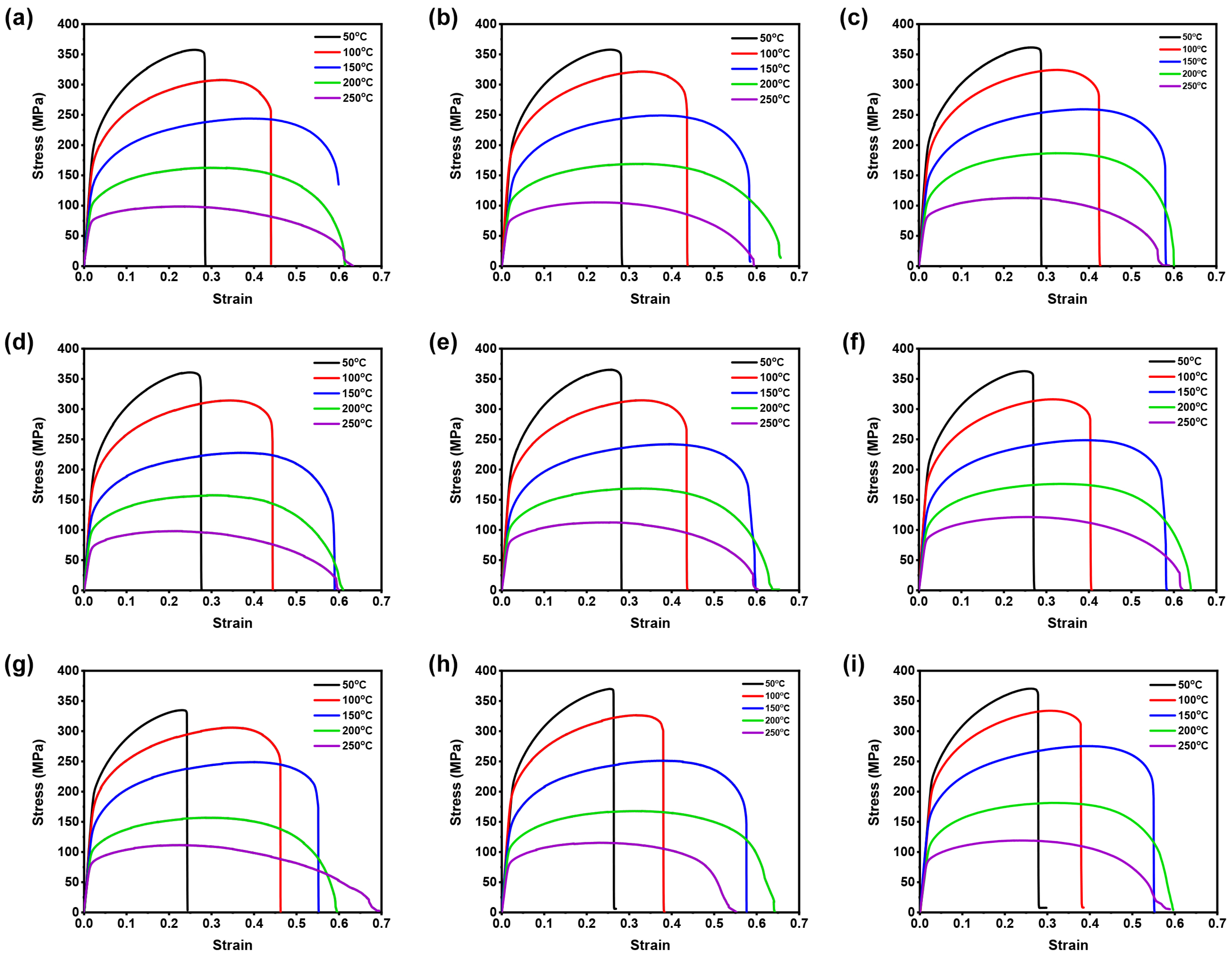
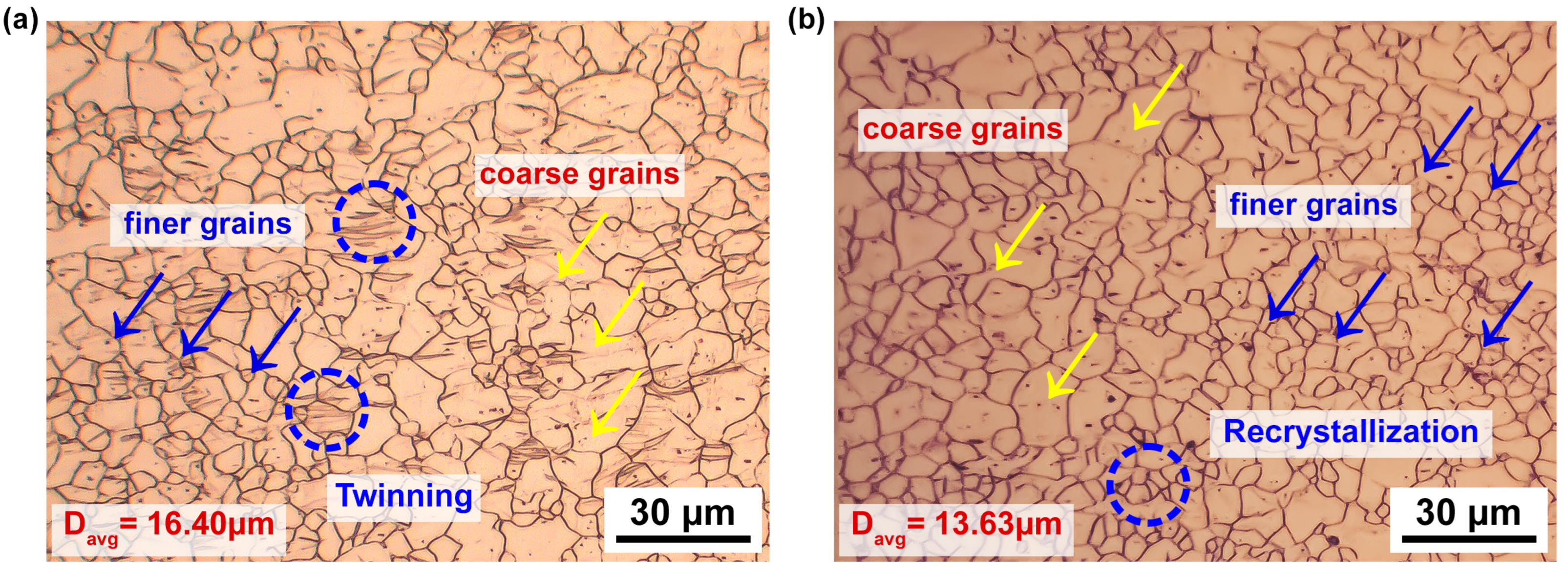
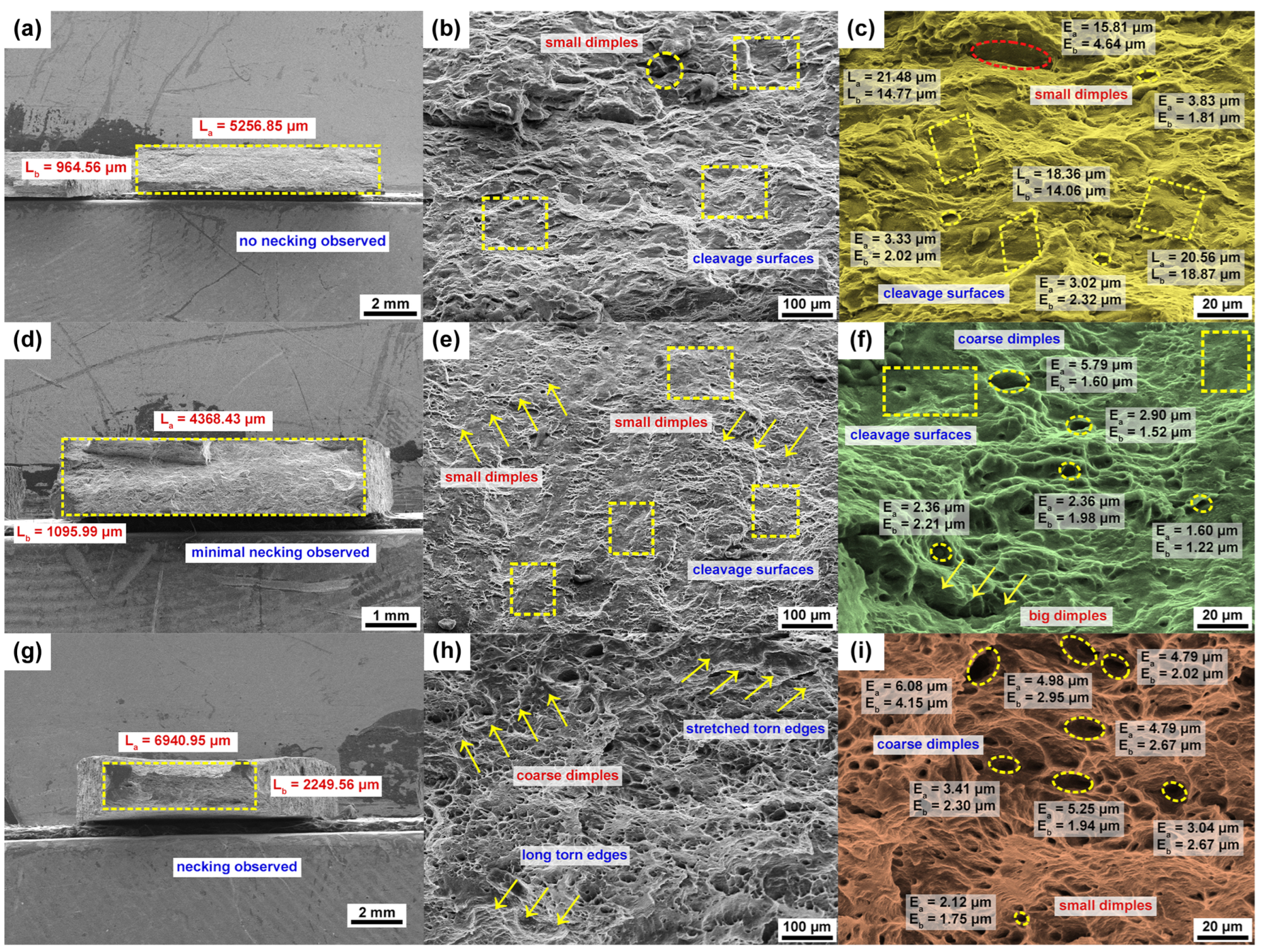
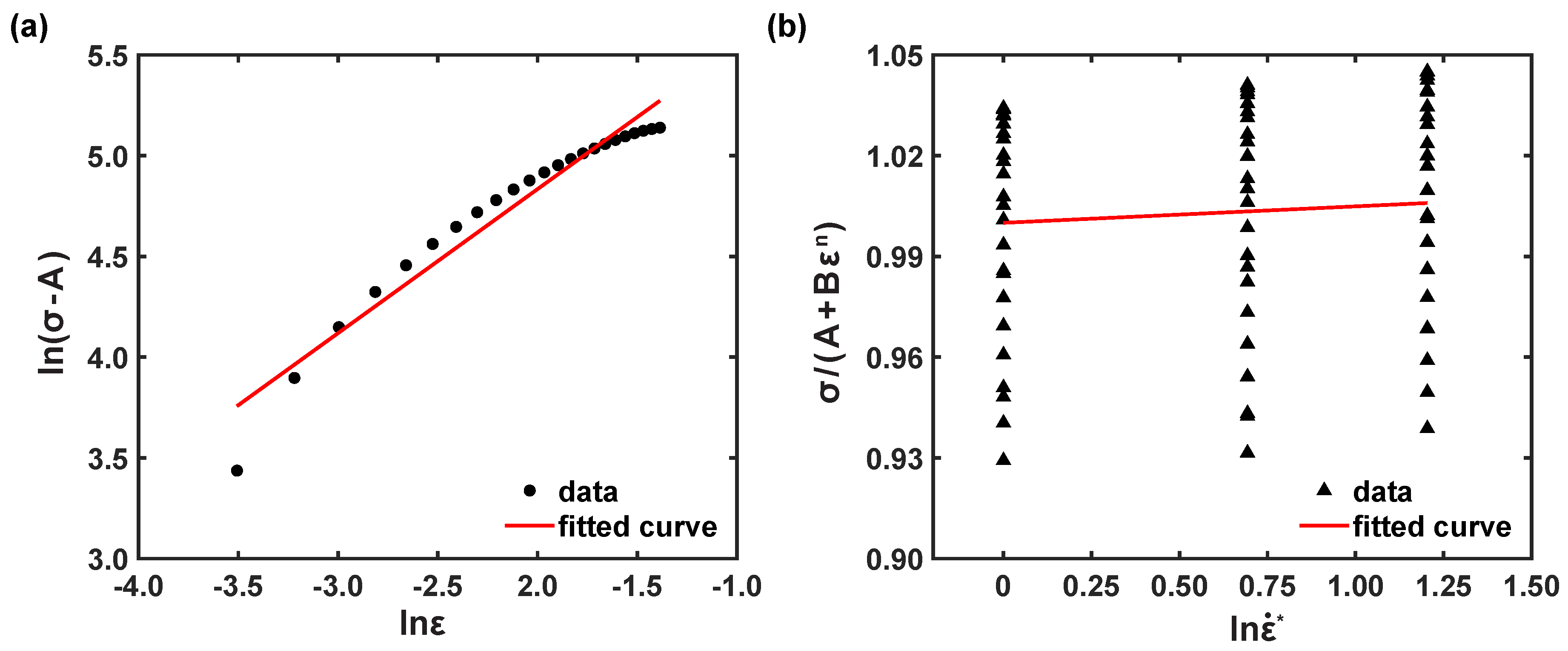
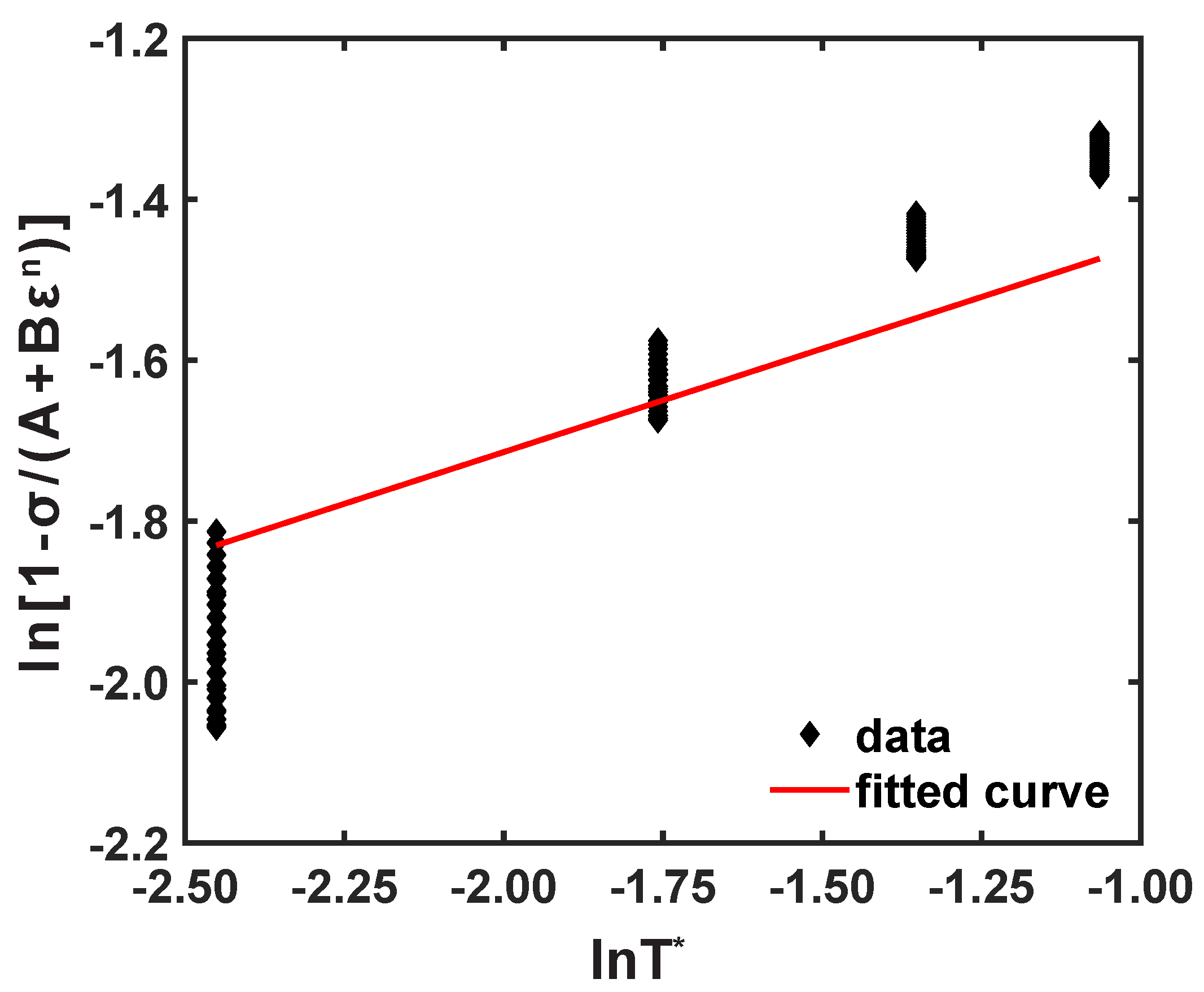
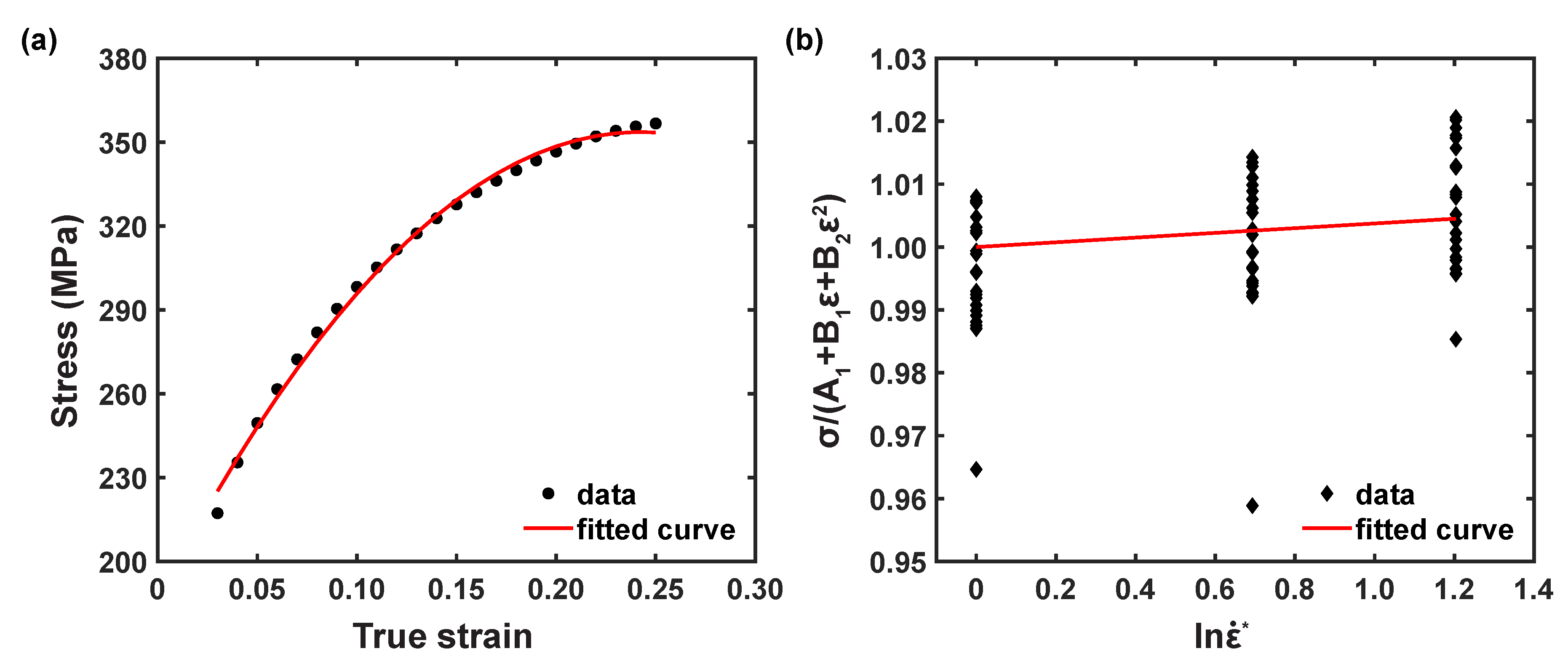

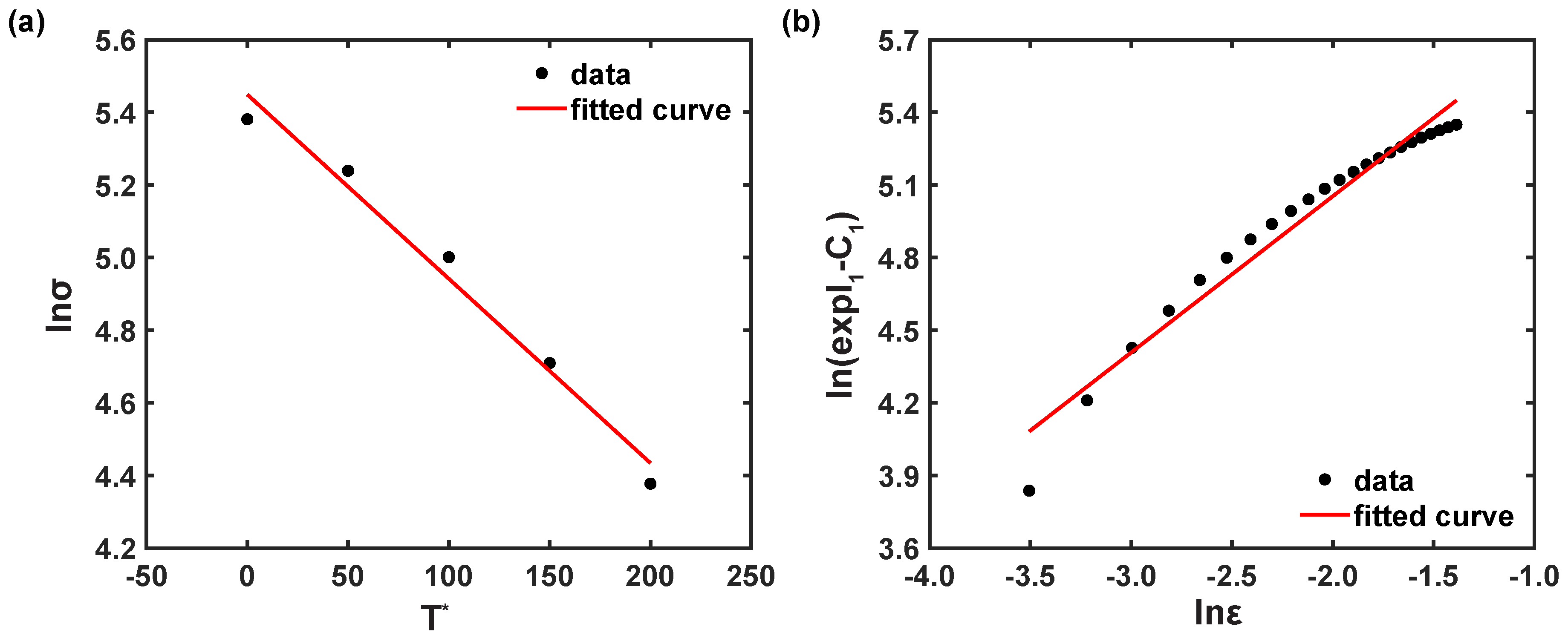




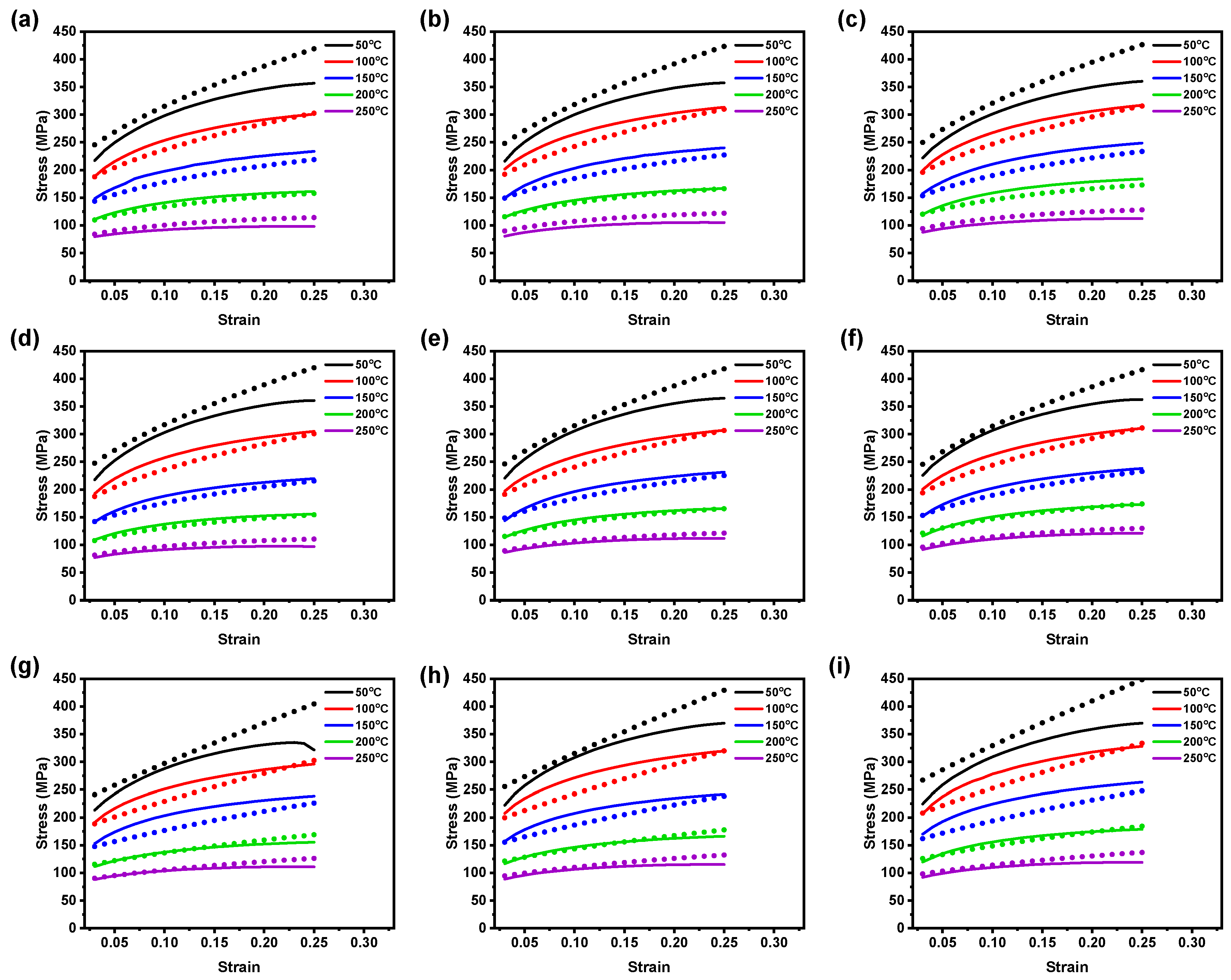
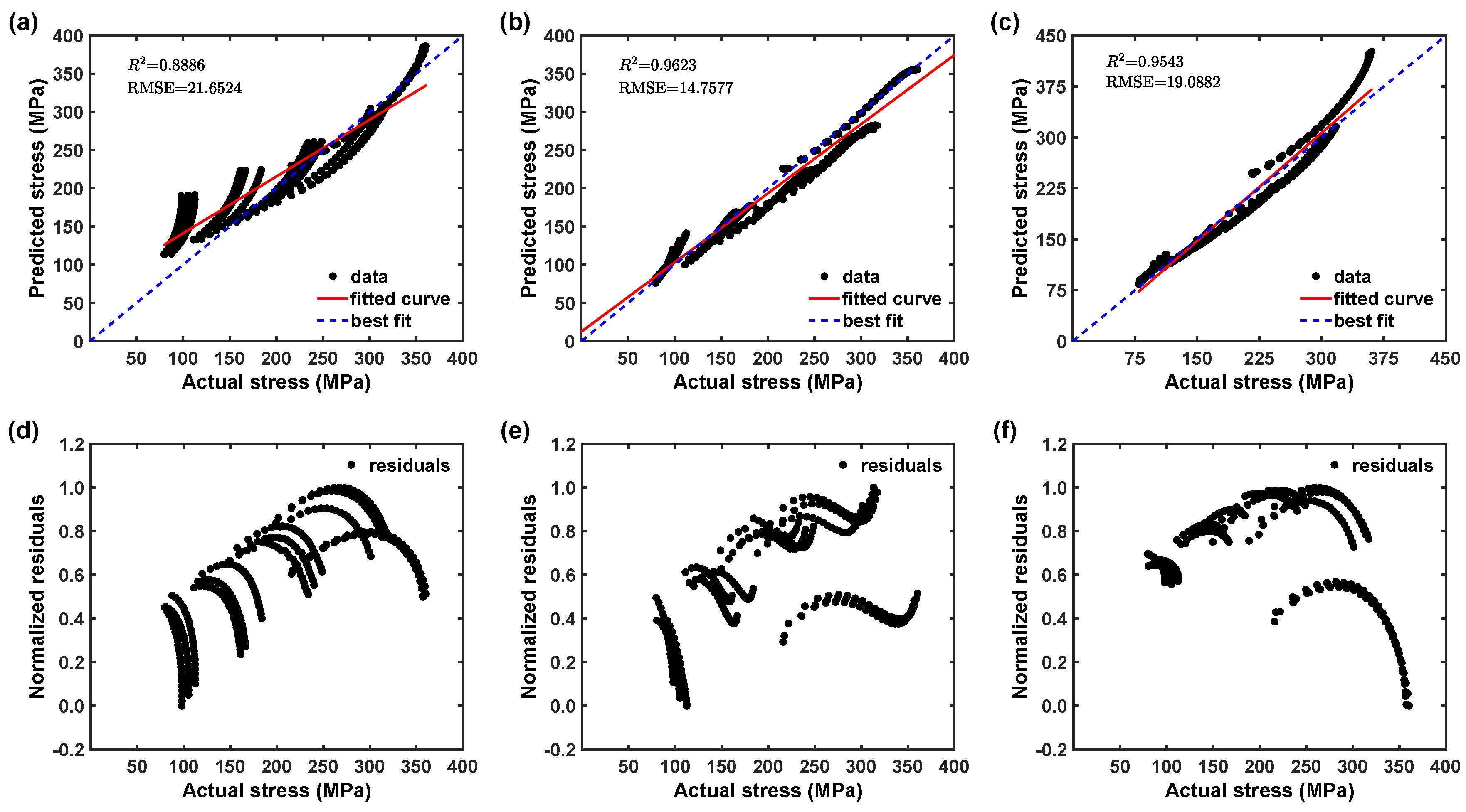

| Angle | Original JC Model | ||||
|---|---|---|---|---|---|
| A (MPa) | B (MPa) | n | C | m | |
| 0° | 186.163 | 536.359 | 0.719 | 0.0049 | 0.643 |
| 45° | 187.871 | 541.828 | 0.707 | 0.0022 | 0.613 |
| 90° | 211.682 | 799.457 | 1.005 | 0.0032 | 0.607 |
| Angle | Modified JC Model | |||||
|---|---|---|---|---|---|---|
| A (MPa) | B | B | C | |||
| 0° | 185.235 | 1422.22 | −2987.32 | 0.0037 | − | |
| 45° | 188.238 | 1457.03 | −3054.24 | 0.0011 | − | |
| 90° | 190.794 | 1439.26 | −2955.42 | 0.0092 | − | |
| Angle | Modified ZA Model | ||||||
|---|---|---|---|---|---|---|---|
| C | C | n | C | C | C | C | |
| 0° | 186.163 | 569.1249 | 0.6453 | 0.0052 | 0.0052 | 0.0149 | |
| 45° | 187.871 | 564.1386 | 0.6405 | 0.0054 | 0.0051 | −0.0074 | |
| 90° | 211.682 | 662.7514 | 0.8908 | 0.0048 | 0.0042 | 0.0854 | − |
| Angle | Conditions | JC Model | Modified JC Model | Modified ZA Model | |||
|---|---|---|---|---|---|---|---|
| Overall | Overall | Overall | |||||
| 0° | 0.005 s−1 | 0.8954 | 0.8886 | 0.9679 | 0.9623 | 0.9611 | 0.9543 |
| 0.01 s−1 | 0.8866 | 0.9607 | 0.9526 | ||||
| 0.0167 s−1 | 0.8919 | 0.9590 | 0.9491 | ||||
| 45° | 0.005 s−1 | 0.8994 | 0.9053 | 0.9751 | 0.9783 | 0.9698 | 0.9736 |
| 0.01 s−1 | 0.9132 | 0.9805 | 0.9760 | ||||
| 0.0167 s−1 | 0.9143 | 0.9795 | 0.9752 | ||||
| 90° | 0.005 s−1 | 0.8550 | 0.8501 | 0.9539 | 0.9519 | 0.9454 | 0.9470 |
| 0.01 s−1 | 0.8680 | 0.9664 | 0.9589 | ||||
| 0.0167 s−1 | 0.8549 | 0.9500 | 0.9372 | ||||
| Angle | AARE (%) | ||
|---|---|---|---|
| JC Model | Modified JC Model | Modified ZA Model | |
| 0° | 13.483 | 8.318 | 7.413 |
| 45° | 13.109 | 5.934 | 4.991 |
| 90° | 13.786 | 7.867 | 6.653 |
Disclaimer/Publisher’s Note: The statements, opinions and data contained in all publications are solely those of the individual author(s) and contributor(s) and not of MDPI and/or the editor(s). MDPI and/or the editor(s) disclaim responsibility for any injury to people or property resulting from any ideas, methods, instructions or products referred to in the content. |
© 2023 by the authors. Licensee MDPI, Basel, Switzerland. This article is an open access article distributed under the terms and conditions of the Creative Commons Attribution (CC BY) license (https://creativecommons.org/licenses/by/4.0/).
Share and Cite
Murugesan, M.; Yu, J.-H.; Chung, W.; Lee, C.-W. Warm Deformation Behavior and Flow Stress Modeling of AZ31B Magnesium Alloy under Tensile Deformation. Materials 2023, 16, 5088. https://doi.org/10.3390/ma16145088
Murugesan M, Yu J-H, Chung W, Lee C-W. Warm Deformation Behavior and Flow Stress Modeling of AZ31B Magnesium Alloy under Tensile Deformation. Materials. 2023; 16(14):5088. https://doi.org/10.3390/ma16145088
Chicago/Turabian StyleMurugesan, Mohanraj, Jae-Hyeong Yu, Wanjin Chung, and Chang-Whan Lee. 2023. "Warm Deformation Behavior and Flow Stress Modeling of AZ31B Magnesium Alloy under Tensile Deformation" Materials 16, no. 14: 5088. https://doi.org/10.3390/ma16145088
APA StyleMurugesan, M., Yu, J.-H., Chung, W., & Lee, C.-W. (2023). Warm Deformation Behavior and Flow Stress Modeling of AZ31B Magnesium Alloy under Tensile Deformation. Materials, 16(14), 5088. https://doi.org/10.3390/ma16145088






